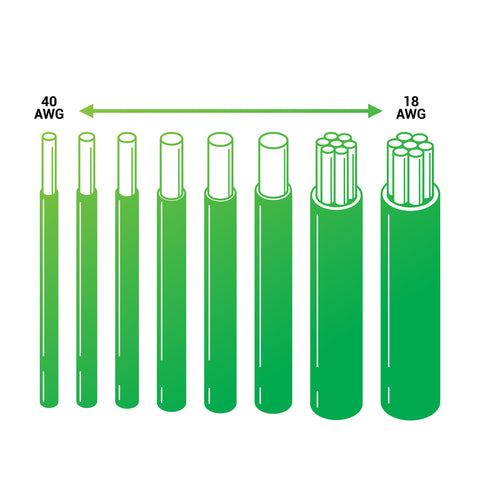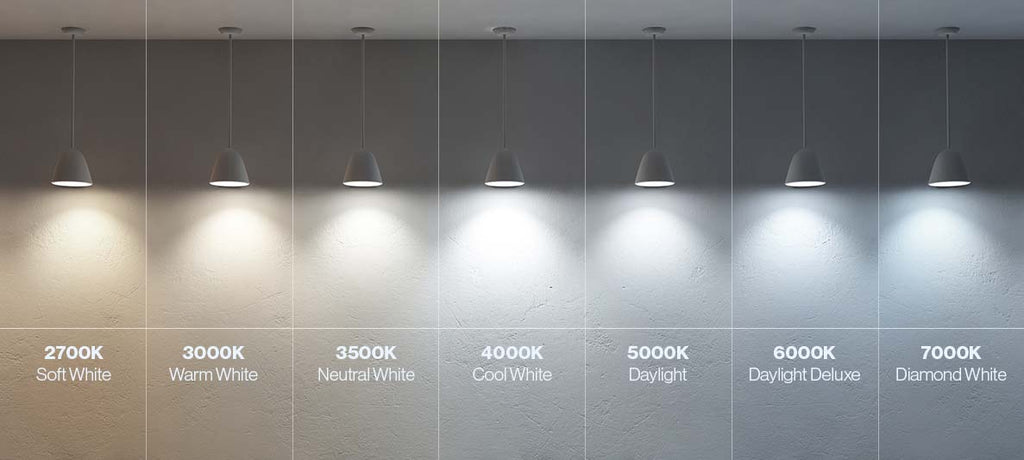How to Choose the Right Wire
Several Sunco Lighting LED fixtures are designed to be hardwired and already include internal wiring to connect to supply wires. Prior to installing these light fixtures, you may find that you need to run a wire to reach your new fixture. This overview blog is designed to help you understand wire standards, the type of wire you need, how to select the right wire gauge, along with how to recognize electrical wire labeling and color coding.
Most LED household lighting fixtures use small wires to carry a low current. There are standards in place to help ensure safety and indicate the ampacity for each wire. Wire ampacity indicates the recommended current levels for a specific wire to prevent overloading that wire and circuit. Naturally, you don’t want your wiring to melt or catch fire, so following AWG standards is necessary when planning your lighting.
AWG Wire Standards
The North American standard for sizing electrical wires was set by the American Wire Gauge system (AWG) and has been in place since 1857. You may also see it referred to as Brown & Sharpe wire gauge. It’s a logarithmic stepped system to indicate the diameter sizing of electrically conducting wires (round/solid/nonferrous). It is not a statement regarding the quality of a wire.
Bigger is not always better. Application and your current needs are what is important when selecting wire.
The AWG standard allows consumers to recognize that a set wire gauge (size) will be rated for a specific amount of amperes or amps. Smaller wires offer greater resistance than larger wires. For instance, a size 12 wire is rated for 20 amps. The current capacity of a wire indicates the amount of current that can be safely carried on that wire.
Wire Size & Amp Ratings for Copper AWG Wires
- 14 AWG – 15 amps
- 12 AWG – 20 amps
- 10 AWG – 30 amps
- 8 AWG – 40 amps
- 6 AWG – 55 amps
- 4 AWG – 70 amps
In the AWG designations, the larger number indicates a smaller wire size.
Ohm’s Law - as resistance increases, voltage decreases.
That means that the diameter of a 12-gauge wire would be larger than a 14-gauge wire.

Wire Gauges and Wire Sizing
Most household wiring, such as you might use for many Sunco Lighting fixtures, and for many appliances in household receptacles, is sized as a 12- or 14-gauge wire. You will see the gauge indicated as a number then a dash and another number:
- 12-2 or 12/2
- 14-3 or 14/3
The first number indicates the diameter of the wire.
The second number refers to the number of wires in a cable.
Cables are sheathed bundles of wires, typically in plastic insulation. You will often see cutaways or cross-sections of cables to show the number of wires inside with colored insulation on the outside.
When referring to wire gauges and sizes, ground wires are often added as a G or a WG, like so: 12-3WG or 12-3G – This representation of a 14-gauge wire includes two insulated wires (live/neutral) with a ground.
Most of Sunco Lighting’s hardwired lighting fixtures include a solid core wire, which is a single solid conductor (copper) wrapped in insulation.
If you are new to electrical wiring, you may be wondering what the different insulated wiring colors and labeling mean.
Wire Color Coding
Another type of standard in wiring is the color of the sheath or insulation that surrounds the wires. The displayed insulation color is an indication of what is carried on that wire:
- Black – this is your live or hot wire. Sometimes it is red instead of black.
- White – this is your neutral wire. Sometimes it is brown instead of white.
- Green or green/yellow, also bare copper – this is your ground wire.
Remember that even a neutral wire passes electricity and so do you. Always turn off your circuit breaker and light switch prior to working on any electrical installations.
If you are installing lights with a dimming option, you will see two sets of wires: the three listed above and then another pair of wires to connect your compatible dimmer. Some fixtures may include a purple wire as the live wire for your dimmer. Always refer to the installation manual and to your dimmer manufacturer’s installation details to see how to safely connect your dimmer and light fixture. If you have questions about your specific wiring and dimmer, please consult with a qualified electrician.
Understanding Electrical Wire Labeling
Each electrical wire includes details about the wiring (wire material, wire size/gauge, type of insulation on conducting wires, voltage rating) printed on the wire sheath when you buy it in bulk. The gauge size format shown above (12-2, etc.) will be included, along with indications of voltage rating. The label will also refer to the wire material, such as CU for copper and AL for aluminum.
Aside from the wire gauge details that are printed on the sheath, you can find other information, too. UL indicates a UL rating from Underwriters Laboratories. NM- labels indicate a non-metallic cable, such as the brand name Romex.
When you purchase extra wire for long wire runs, you may also run into letters that indicate specific things. Some letters you might run into when wiring lighting would include whether the wiring is heat resistant (H or HH for higher heat resistance), flame retardant and made of a synthetic polymer (X), and approved for wet or damp locations and can be used in dry (W). Any additional letters would be explained by the manufacturer of that roll of wire.
Hardwiring and Long Wire Runs
Long wire runs can produce smaller voltage the further you are from the transformer, which is why you typically need large gauge wire for 50ft or more. You need to engineer your low voltage lighting system with balanced runs that are wired for the appropriate loads.
For low voltage lighting in long wire runs, such as exterior landscape lighting, you may want to go with a 12- or 10-gauge wire to prevent voltage drop. Electricity is a lot like plumbing in that it deals with current. Look at a sprinkler system and you will see that to retain water pressure you cannot use a lot of sprinkler heads on the same line. The same applies to electricity.
Adding too many fixtures onto the same circuit can cause each light to not receive enough voltage or to disrupt your power flow in ways that can be detrimental. This is why planning your lighting, using a voltmeter to check voltage on existing lines, and consulting with a qualified electrician is very important.
Wiring Resources
There are a number of free online resources available to help you reference wire types, along with some simple calculations. You or your electrician can also do some of your own calculations.
Voltage Drop
You can estimate voltage drop with this free Voltage Drop Calculator. If you prefer, calculate Voltage Drop Index (VDI) yourself with this formula:
VDI = AMPS x FEET ÷ (% VOLT DROP x VOLTAGE)
Where:
- Amps = watts divided by volts
- Feet = one-way wire distance measurement
- % Volt Drop = Percentage of voltage drop acceptable for this circuit
Circuit Requirements
Remember that you will want to determine the load requirements on each electrical circuit prior to beginning any lighting installation. Circuit requirements is an easy calculation, simply:
- Add the wattage of all electrical devices on a specific circuit.
- Divide that wattage by the voltage (120V or 240V).
- The resulting number is your required current or amps for that circuit.
This blog is only to help you understand the basics of wiring. We recommend you speak with a qualified professional electrician regarding any wiring, circuitry, and lighting fixture installations.
Sunco Lighting offers hardwired products, including our Wraparound Shop Lights, Wall Packs, and select downlights such as our: Disk, Slims with junction boxes, New Construction Cans, and Remodel Cans. We will soon have an expansion of lighting fixtures that include more hardwired lighting options.
Want to know more about some of the products Sunco offers as of this blog posting? Check out these blogs:
1 comment
-
Posted on by bernardeducational


